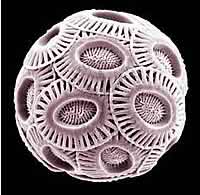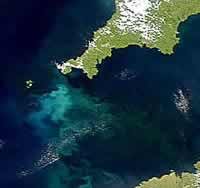Emiliania huxleyi
205Kb download [click and drag the image to rotate the exhibit]
This is a 3-D model of the fossil coccolithophore, Emiliania huxleyi. Coccolithophores are algae (single celled plants) that float in the oceans and 'Ehux' is the most common species. The model is of the calcite 'scales' that cover the algae.

Coccolithophores are microscopic - about 1/100th of a millimeter across. Because they are so tiny, they are only seen clearly in electron microscopes.
'Algal blooms' of these tiny organisms occur frequently at higher latitudes (such as around Britain). At this time, coccolithophores become so numerous and densely packed that they can be seen from space.
When they die the scales sink to the seabed. These calcite deposits on the seabed, over many millions of years, make up what becomes limestone.
Also see:
- Coccolithophores in the Museum's Picture Library.

External links:
- Emiliania huxleyi Home Page from Toby Tyrell at at Southampton University.
- Coccolithophores in Nasa's Earth Observatory.